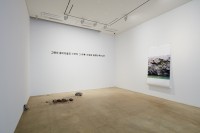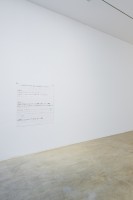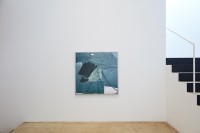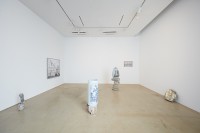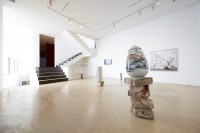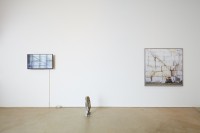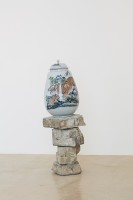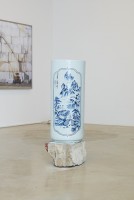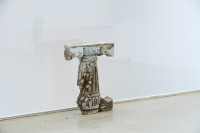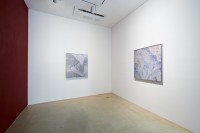A Position for Approaching Photography When It Becomes an Object
: Poking Fun at the Phenomenology of Photography
SEO Dong-Jin
Shedding tears in the cold rain/ lonely boulder trying to heal its heart in the white snow, …/
Roll, roll, roll, roll, boulder, let’s laugh at the edge of that sky
How does it feel/ How does it feel/
To be without a home / Like a complete unknown/
Like a rolling stone?
1.
It seems that the most popular philosophical and aesthetic concerns today relate to questions of being and objects. These questions claim to escape the ideologies of the subject/object relation that have been a dominant preoccupation over the past few centuries. For example, consider the stone. Let us follow with a question, is it an object, a thing, or a being? This stone may be expensive granite imported from Turkey, or quality marble from Italy. (I once heard an anecdote that renowned Korean sculptors in the 1970s went to study abroad in Italy to find the best materials and made works in the quarry.) As materials either for architecture or sculpture, stone summons a notion of the subject – the human that treats and manipulates them. Therefore, rocks ─ identified as non-ego oriented objects ─ confront the human subject. They make a pair with the subject, who manages and alters them, which is to say the subject faces the object through an act of reckoning.
However, the moment a rock is designated as being, the situation changes fundamentally. In bringing up concepts such as being or ontology, the discourse often vetoes or rejects critical philosophy via German Idealism and its succeeding theories that adhere to the philosophical lineage of Kant-Hegel-Marx. For example, one may recall the ontological shift in the question of being in early 20th century philosophy addressed by Heidegger, although it should be noted that this was not simply a return to pre-critical philosophy; it was an attempt to overcome the inadequacy of Modern thought in order to establish a post-critical philosophy and art theory. In any event, the dispute over subject/object is not an isolated affair that only occurs in the speculative domain of theory. One may consider it to be an eternal tension lurking in our thinking and experiencing of the world. It can be said that critical philosophy and its ontological inflections emerged in modern bourgeois society only to become like players in a game with dangerously high stakes. I haven’t the time to discuss these issues at length in this paper - it is more so the case that I cannot help but be reminded of such antagonisms upon being given a stone, or, more properly an image of it.
From the subject’s point of view, being is not something that is reconcilable, reducible or easily sensed; being is closer to a fanciful thought or a delusion. What is unknown to my/our subject ─ in other words, what exists before given, empirical objects ─ must remain a mystery or be kept repressed. It is a well-known fact that Kant had provided a name to such a conundrum by designating a concept of the stone itself. Interestingly, the stone takes up a very important role in Kant’s philosophical speculation. Less known is the fact that Kant is one of the founders of seismology. In regard to the Great Lisbon earthquake, Walter Benjamin describes its unprecedented atrocities in Western European history in the text for his radio show ─ which was largely directed toward German children. He casually introduced Kant to his listeners by suggesting that if they were German children, they may have heard the philosopher’s name mentioned a few times. Benjamin’s humorously understated portrayal of Kant is a curious attempt to promote him as an exceptional pioneer of rational science in attempting to shift popular conceptions of stone from being to object.
In Königsberg, a small city which he supposedly never left his whole life, Kant ─ then a 24-year old scholar ─ analyzed all of the documentation and data available to him on the Great Lisbon Earthquake, which irreversibly shocked the European mind, in formulating a theory of the causes of earthquakes. He inferred that earthquakes were caused by a shifting of the 300-kilometer-thick surface of the earth, as opposed to what was then commonly believed to be the wrath of God or the eruption of boiling liquefied waves of rock. His seminal texts that investigated the earthquake scientifically are Universal Natural History and Theory of the Heavens. Through these publications, Kant experimented with the capacity of humanity’s limited scientific reasoning. It would not be an exaggeration to say that it turned the mysterious substance of stone ─ which had been previously understood as the deliverance of God’s will ─ into an object of study, more specifically for geology and seismology.
Consequently, stone can be perceived in various ways. The philosopher’s stone? If not that, we can imagine diverse kinds of stone. At a glance, there is nothing more obdurately inert or indifferent as an object than stone. It seems as though it forcibly insists on its objecthood, with no attention paid to the subjectivity facing it. Having been formed prior to the Great Lisbon earthquake and eroded in European consciousness, the images of lava or boiling flows of stone are no longer applicable. When the Europeans heard the voice of God reverberated in stone, the stone might have been a being, preceding the division of subject and object. Benjamin’s reflections on Kant’s scientific observation of the convulsion of stone that swept over Lisbon does not appertain to fragments of being but stone which human rationality must patiently endeavor to analyze. Through the logic of scientific reasoning, stone was transformed from subject to object thanks to the burgeoning fields of geology and seismology, to which Kant contributed enormously.
2.
Today, our perception of subjects and objects is cast in a different light. The various shifts identified as ontological or aesthetic turns strive to restore affect and beauty in lieu of subject and object. They reprimand the hubris of modern metaphysics, which deems everything external to the subject itself to be object. They rebuke the myth of subjectivity in the subject-oriented pursuit of meaning and ideology, and its abandonment of beauty as located specifically in object or image. They appeal that the subject and object both are placed in one and the same chain of being. For that reason, some call this kind of ontological thought “flat ontology”. It insists that we consider human, nature, machine, object on the equivalent plane of a lateral structure, without privileging the subject over the object.
Nonetheless, there is no need to further intervene in such philosophical discussions. We are now tasked with entering Joongho Yum’s exhibition, The Stone of the Monster. The work in this show is composed of stones, images of stones, and meditations on stones. Yet, it inevitably reminds us of today’s philosophical or aesthetic discourses. I would like to believe that I am not alone in being absorbed by such a feeling. The case is very simple; the photographic image of stones may be more uncanny than we initially expect. First, let us raise a somewhat silly question. Can a stone be the object of an image? Needless to say, no restriction exists regarding the possible subjects for a photograph. Everything that is captured by the camera is mobilized and transported as an image, whether it’s the interior of my body as scanned by a camera that travelled through my esophagus in medical imaging, or the infinite space and innumerable planets transmitted to earth by a camera on a spacecraft. So what about stones? Can stones be the object of an image? Upon this question, my previous conviction is shaken, because it seems somehow awkward for stones to become an image. Why shouldn’t stones be the object of an image, when we know any and all subjects are equally eligible? Again, stones often enter the frame of a photograph; stones acquire qualification as a photographic image for serving such purposes as geological categorization or product catalogs for stone dealers. Notwithstanding, it is somehow disconcerting to think about the photography of stones in the same vein as portrait or landscape photography, or documentary photography.
What we call photography, here, is undoubtedly the production of photographic images. Image is, like language, a means of conveying meaning, a feature of the medium that preoccupied photographic theory for a significant period of time. Photographic theory has persistently disputed whether photography functions as icon, index or symbol among language. However, with regards to the photographic images of stone, it is hard to make an argument. Let us imagine a high-definition image of a basalt sculpture. It is hard to retrieve a meaning. It presents the stone as an object itself, not as a photographic image or a sculptural language that requires decoding. Perhaps, we encounter photography as itself, elevated ─ an object autonomous from codes, symbolic order, or narrative grammar. I suspect that this may pertain to the enigma of what the semiologist of photography Roland Barthes called the “punctum”.
Nevertheless, it is undeniable that the images we often see today are on the trajectory from image-photography towards becoming object-photography. It seems a long time has passed since the discourse on photography was mainly concerned with its status as a social symbol. Evident in our desire to see the object called a photograph is perhaps a reaction against or an exhaustion of the theoretical injunction to read photography as language, upon which Marxist or Feminist’s critiques informed by linguistics and psychoanalysis had insisted for so long. Throughout numerous spontaneous occasions and dialogues with many artists and photographers, I have heard repeatedly that photography must focus on its beauty, the aesthetic potential its photographic surface is capable of producing. Some have used such bold and familiar expressions as “photography for photography.” Liberated from serving as language-image, photography is on an open path to being in itself.
3.
How does the exhibition, The Stone of the Monster attempt to intervene in this contentious theoretical current? Surprisingly, the artist Joongho Yum appears as though he pays no attention to such trends. Capturing either the surface of pottery, wood or architecture, he lightly passes over the stealthy aesthetic claims posed by high-definition photography of emotional intensity. He feigns ignorance as if he has never experienced the phenomenology of photography as it pertains to the coordinates of current photographic practices. In addition, through the use of stone as a medium and subject of his work, he pretends to assume and recognize the state of cultural affairs today. Intersecting in his practice are Suiseki collectors, their collections, stones that appear in mythology, stones occupying residential spaces; and the utterances of stone collectors, painted with crushed stone dust. As if aiming to restructure the materiality of stone, the artist attempts to create the stone of the monster by kneading the debris from producing bricks, concrete and ceramics. Interestingly, some of Yum’s photographs were taken after seeing online images of a scenic spot or specific cultural location posted by travel writers or other photographers. He does not care one bit about the photographic trend of searching for a vague ontological flavor, and does not hesitate to treat photography as abject image from which information is collected and consumed.
In that respect, I kept misreading the exhibition title, The Stone of the Monster as The Photograph of the Monster. This was partially because the works in the exhibition were read as individual units employed for presentation, but there were other reasons; I came to think that Yum may be contemplating the (im)possiblity of photographic images while posing to establish the cultural dispositions and vestiges surrounding stone. As he argued in the artist statement that he sent me, he thinks stone “makes up an essential material, continually present in human history,” but immediately carries on to poke fun at just such a thought. He encounters humorous and crude-looking stones from hobby-clubs, or sometimes sneers at decorative stones that are commonly found in Korea. However, these recollections of Yum’s are not a report on the contemporary consumption of stone, let alone a project of cultural anthropology. He repositions what he recognizes in the stone into the space of photography. Similar to the way stones in a quarry are cracked, stored, collected, eroded, decorated, commemorated, and abandoned, he arranges photography in its existing place within the dominant modes of media and communication. In this regard, I am reminded of Yum expressing that “this exhibition might be one precipitated by a number of other selves.” In presenting a series of images of stones, the artist is not speaking of the stone itself, or the intransient substance within the object; the exhibition presents the results of multiple discrete gestures, their effects, coordinates in time, and fleeting historical moments. Throughout, these works are suffused with the potential for even a worthless stone to gain meaning, depending on how or through what kind of context its image emerges. Furthermore, Yum’s works reply to the ubiquitous gestures being made today that search for the truth of photography within photography itself. Of course, his response is lighter than it is serious, because one of the best ways to productively destabilize even the most serious and profound of arguments is by making a well-placed joke.
